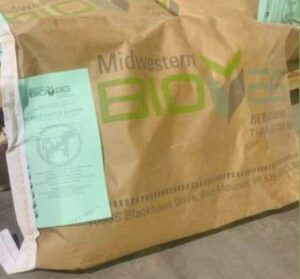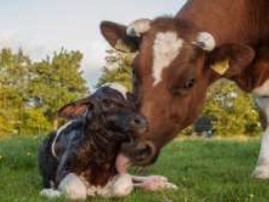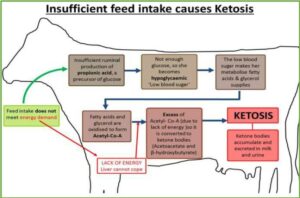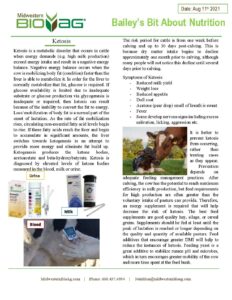Ketosis
Ketosis is a metabolic disorder that occurs in cattle when energy demands (e.g. high milk production) exceed energy intake and result in a negative energy balance. Negative energy balance occurs when the cow is mobilizing body fat (condition) faster than the liver is able to metabolize it. In order for the liver to normally metabolize that fat, glucose is required. If glucose availability is limited due to inadequate substrate or glucose production via glycogenesis is inadequate or impaired, then ketosis can result because of the inability to convert the fat to energy. Loss/ mobilization of body fat is a normal part of the onset of lactation. As the rate of fat mobilization rises, circulating non-essential fatty acid levels begin to rise. If these fatty acids reach the liver and begin to accumulate in significant amounts, the liver switches towards ketogenesis in an attempt to provide more energy and eliminate fat buildup. Ketogenesis produces the ketone bodies, acetoacetate, and beta-hydroxybutyrate. Ketosis is diagnosed by elevated levels of ketone bodies measured in the blood, milk, or urine.
The risk period for cattle is from one week before calving and up to 30 days post-calving. This is because dry matter intake begins to decline approximately one month prior to calving, although many people will not notice this decline until several days prior to calving.
Symptoms of Ketosis:
- Reduced milk yield
- Weight loss
- Reduced appetite
- Dull coat
- Acetone (pear drop) smell of breath is sweet
- Fever
Some develop nervous signs including excess salivation, licking, aggression, etc.
It is better to prevent ketosis from occurring, rather than treating cases as they appear.
Prevention depends on adequate feeding management practices. After calving, the cow has the potential to reach maximum efficiency in milk production, but feed requirements for high production are often greater than the voluntary intake of pasture can provide. Therefore, an energy supplement is required that will help decrease the risk of ketosis. The best feed supplements are good-quality hay, silage, or cereal grains. Supplements should be fed at least until the peak of lactation is reached or longer depending on the quality and quantity of available pasture. Feed additives that encourage greater DMI will help to reduce the instances of ketosis. Feeding yeast is a great additive to stabilize rumen pH and microbes, which in turn encourages greater mobility of the cow and more time spent at the feed bunk.
Product of the Week: “O” Free Choice Buffer

-
-
-
-
-
-
-
-
- Contains calcium and magnesium sources with rumen buffering capabilities.
- Provides clay-based buffers such as montmorillonite and bentonite.
- Contains yeast culture to help stabilize the rumen fermentation process.
- Serves as a highly palatable free-choice
-
-
-
-
-
-
-




